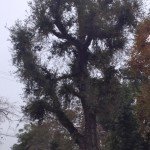I’ve had a number of queries regarding the proper watering of native California oaks during this drought. I wrote an article on Oak Tree Care in 2012, and most is current, but I wanted to re-tap some experts for tips during this drought. So along with a quick review and some good and bad pruning examples, here you go.
Water this Winter if Drought Continues
Think of oak trees in the wild. They exist on natural rainfall, with growth slowing during the late summer heat. The normal recommendation is to not water them in the summer months, and only provide water other seasons during unusually dry periods. With our ongoing dryness, I checked in with native plant expert Bart O’Brien, now the director of a prominent native plant botanic garden, the Regional Parks Botanic Garden in northern California. Here are his recommendations for recently planted oaks and old ones.
For long-established oaks, O’Brien suggests deep watering in winter through early spring during periods of drought. So unless, we have an El Nino that brings in considerable rain, consider extra watering this winter. “Luckily, this time period is when landscape use of water is lower during winter, and it provides these majestic trees the water they need when they can actually use it,” O’Brien says.
Most experts agree that water should never be introduced to an old oak in the summer, especially for trees that did not grow up with summer water, because it may encourage root fungus diseases that are often fatal. The late Bert Wilson of Las Pilitas Nursery, a native plant nursery in Escondido, recommended that if your old trees have received irrigation water most of their life, keep the same regimen. But, if watering was a recent introduction, remove it gradually – over a period of a year or so.
Also, check the irrigation spray in your yard. It’s important to avoid spray hitting the trunk. And because water at the base of the trunk causes most root diseases, avoid watering six to eight feet around the trunk of a mature oak tree.
Watering with Newly Planted Oaks
If you have an oak that you or a previous owner has planted O’Brien provides slightly different guidelines:
- For an older tree – 15 plus years – that has been in the landscape for years, continue the irrigation regime that the tree has grown up with as that is what it has adapted to
- For younger trees, keep in mind that you can get a newly planted oak to adapt to drier conditions
- Water new plantings – You will have to water a newly planted oak for at least a few summers before it will survive with minimal to no summer water, says O’Brien, adding that the size of the tree when planted, and your soil conditions play role. For example, a tree planted in clay soil will require less water.
Underneath your Tree

- Leave the oak’s natural leaf litter – it’s the best possible mulch. Microorganisms in the layer where the oak leaves meet the soil protect the oak from diseases. Also, the leaf litter provides important habitat for numerous insects that birds depend on, helping make oaks a keystone species for healthy ecosystems.
- Avoid planting under the oak’s canopy – or use associated native plants. If you need to plant something, use plants that require similar soil types and water requirements; for example, use native plants that are normally associated with native oaks, such as Currants (ribes species)or coral bells. Las Pilitas has a good website page on this, which lists 20 good choices.
- Avoid azaleas or rhododendrons near your oaks, as their different soil requirements can harm the tree.
- Remove non-native plants, including weeds, from under the native oaks. The late Bert Wilson said in an earlier interview that this makes a dramatic difference.”People should not disturb the soil when they remove them, i.e., cut them off at ground level instead of digging them out.”
- Don’t use rocks directly around the base of oak trees, as the moisture they retain can kill the tree through drowning or fungus.
- Avoid soil compaction, especially during heavy construction – click here for more info
Pruning: Little to None
- Mature oaks need no pruning. If some is necessary, never prune more then 10% green out of your oak. Certified arborist Paul Chaney uses long-standing industry standards to not exceed 5% annual foliage removal for large mature trees, so that’s one branch out of 20.
- Oak trees can get sunburn too on their trunk and main branches, when too much green foliage is trimmed. Pruning is best in late summer to early fall but arborists in hot areas prefer cooler months. “I like to wait until later in the summer, or early fall, because foliage removal during extreme heat heaps one stress on top of another–and that can’t be good,” said Chaney.
- Never top oaks. These abnormal cuts on main branches create weak branches, and the oak can never get back to its majestic shape.
Here are some pruning examples:
For more info:
Native Oaks in California (Las Pilitas website) – list of oaks
Great book – Oaks of California by Bruce Pavlik, et al




Thank you for the information. I have been concerned about my healthy 100 year old oak during this drought. I’ll attend to watering needs in the winter if El Nino passes us by. Thanks!
It won’t hurt and will love kelt help it now to give it some extra water if you’re in an area that hasn’t received some precipitation. Good luck
Than you for the information
I have an oak tree in my front yard, it was planted by the developer in 1999 and has grass around. The yard is not level, and is sloped steeply downward. Always had a hard time growing grass, it thins and than the rabbits eat it. It is really thin/bare now with the cut back in watering.
Eventually I will need to do something about the HOA after the drought. They love their green grass in SoCal. What are the best options, it seems whatever I do will harm the oak tree if I prepare the soil for new sod or even take out the sod. Any suggestion what to do and what to tell the HOA if I do not put grass back in. PS I have never had so many acorns this year fall, everyday I pick up a bucket full for a month or two.
Thanks
Doug
Hi Doug- there are good online resources to share with your HOA- here’s one on appropriate plants under oaks- but the oak’s leaf litter is easiest and healthy for it. Or put some mulch around the tree’s drip line.
http://www.laspilitas.com/groups/oaks/Planting_under_oak_tree.html
I’m not an expert so I would check with a local nursery that knows native oaks but my understanding is you can lightly remove the grass- (after you get the ok) – but at the same time don’t remove all the water it was used to getting, esp if this El Ni
We are in the foothills north of Pasadena and have a Coast Live Oak that is right on the property line (actually, in the utility easement). The adjoining neighbor who has the trunk on his side of the fence cut back heavily on watering I learned today from him in response to the drought and some landscaping changes. Even though they are protected, I suppose you can starve an oak but not cut it without a permit. Odd. Anyhow, I did not notice the problem – a neighbor alerted me – since my side of the tree is fine as I have cut back but not ceased watering entirely to support multiple trees on the property. So, after some research I’m deep watering the old guy and hoping the rest of the tree will hold out until the rains come next month or so. Any thoughts?
Sounds like you’re doing the right thing – and the rains should come soon… It wouldn’t hurt to contact your city to share your example – If you are in Pasadena I know they have an active tree program. Here is a state resource to share w/others: http://saveourwater.com/what-you-can-do/tips/landscaping/save-our-water-and-our-trees/
I live about 5 miles southeast of Pasadena, CA, and like a writer above, I share a tree with the neighbor. The truck is on his side, but 5/6 of the canopy is on my side. It is so lop-sided because over the last 40 years various owners have planted other trees in that large yard forcing the oak to grow my way. The yard was watered once in while and the acorns were normal until the last owner raised free roaming chickens and over watered causing green acorns to drop before their time. The little house sold in 2014 and was torn down and replaced with a much larger house which was finally completed in April of 2016. During construction the nothing was watered and no acorns were produced.
Then in late April the landscapers came in and bulldozed everything in the backyard except the oak and 2 small fruit trees on the other side of the lot. They put in a large sod lawn and lots of pansies around all 3 trees and have bushes along the 3 walls so it would looked nice for Open House. The sprinklers go on 2x a day/night 7 days a week. They have at least 8 stations.in the backyard, The house finally sold in early June. The new neighbors have put in only a minimum of furniture and no one is around much. Now in July the acorns are dropping and are very tiny, green, and sticky. It seems to me that they are overwatering. My city is still on twice a week watering. Despite that most of the acorns fall in my yard, I don’t want to lose the tree. What watering advice can I pass on to my new neighbors about this Oak? Thank you
so you’re not in Pasadena, which has a strong tree policy – if you are, call the city and this oak is likely protected and they can help with education. If not, print out oak care info – there’s my website articles on care of oaks including this one – https://ifnaturecouldtalk.com/taking-care-of-our-california-native-oaks- and others on the web. With the ongoing drought some watering of mature oaks is warranted but this one you described is definitely getting too much. I think the neighbors would be glad to cut back on watering.
The Quercus agrifolia at my Carmel home (Calif. central coast) was badly defoliated this summer by oak moths. Before the defoliation happened, I had been planning to do a 10% trim to keep it from banging into the roof during the next winter storms. Now I don’t know what to do. I presume it will recover, but it looks bare and ragged now. Last winter was particularly wet, after a particularly dry winter the previous year. Do you have a suggestion about the best care, and whether it is OK to do a trim of outer branches in it’s current condition?
Hi Marguerite, I don’t have any experience with the effects of oak moths. An ISA (International Society of Arboriculture) – certified arborist is your best bet to give you an opinion on it’s current state and trimming – though it certainly sounds reasonable to do the trimming you plan. Many will do free consults. Check http://www.isa-arbor.com/findanarborist/arboristsearch.aspx Good luck.